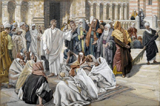| Notes: | "...when his (Tissot) carefully researched collection of 350 watercolors depicting the life of Jesus was first published as a book in 1896, it found a large and enthusiastic audience. No one who had followed his previous career could have anticipated that this painter of urban life in Paris and London would undertake the project of painting virtually every event in the Gospels.
The Life of Our Lord Jesus Christ project took nearly ten years to complete. When it was done, it chronicled the entire life of Jesus as recorded in the New Testament in a series of 350 watercolors. To research the project Tissot traveled to Egypt, Syria, and Palestine in 1886–87, and again in 1890.
While in the Holy Land he closely observed the landscape, the vegetation, the architecture, and the manner of dress, and filled sketchbooks with what he saw. He talked with rabbis and studied Talmudic literature as well as theological and historical volumes. He believed that there was still a remaining “aura” in the places where the Gospel events took place, and he spoke of having mystical experiences that added to his careful research. What he wanted to create was something as close as possible to an eyewitness account of the life of Jesus." [from Terry Glaspey's "75 Masterpieces Every Christian Should Know"] |
|---|
| Attribution: | Tissot, James, 1836-1902. Pharisees Question Jesus, from Art in the Christian Tradition, a project of the Vanderbilt Divinity Library, Nashville, TN. https://diglib.library.vanderbilt.edu/act-imagelink.pl?RC=57053 [retrieved April 3, 2025]. Original source: https://commons.wikimedia.org/wiki/File:Brooklyn_Museum_-_The_Pharisees_Question_Jesus_(Les_pharisiens_questionnent_J%C3%A9sus)_-_James_Tissot.jpg. |
|---|

